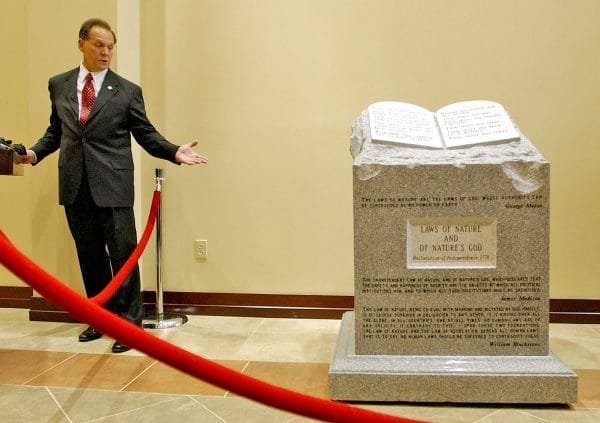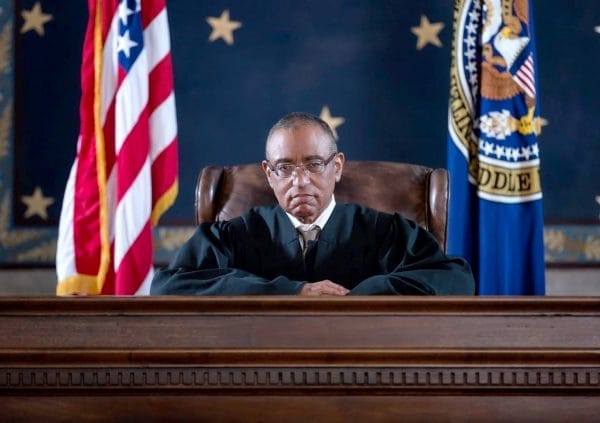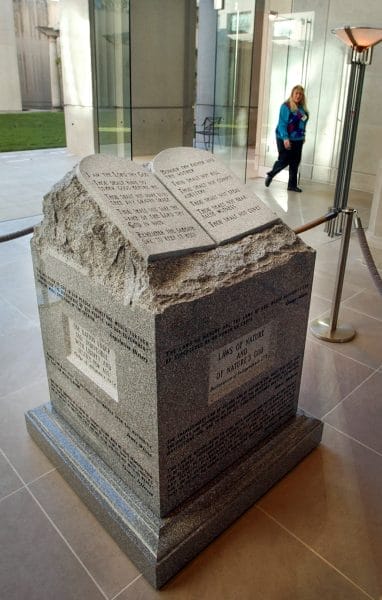Ten Commandments Monument Controversy
In 2001, Alabama was thrust into the center of a national controversy about the presence of religious symbols on government property when Roy Moore, then chief justice of the Alabama Supreme Court, installed a 5,280-pound granite monument depicting the Ten Commandments in the rotunda of the state’s judicial building. Moore already had a reputation in Alabama as the “Ten Commandments Judge” after a legal battle over a small wooden display of the Commandments that he hung in his Etowah County courtroom, where he was a circuit judge in the 1990s.
 Roy Moore
On August 1, 2001, six months after beginning his term as chief justice, Moore placed the monument, carved by Huntsville sculptor Richard Hahnemann, in the rotunda of the judicial building in Montgomery, which houses Alabama’s Supreme Court, Courts of Appeal, and state law library. The installation was filmed by Coral Ridge Ministries, an evangelical Christian media outreach organization, which sold videos of the installation to raise money for its ministry and later for Moore’s legal defense. The top panel of the cubical monument prominently featured the Ten Commandments on two tablets, and the sides of the monument were engraved with quotes relating to the importance of God in society from sources such as the Declaration of Independence, the Alabama Constitution, and the writings of the Founding Fathers. Moore claimed that the granite monument, which he and his cohorts installed in the middle of the night without the knowledge of his fellow justices, depicted “the moral foundation of law” and in his opinion reflected the sovereignty of the Judeo-Christian God.
Roy Moore
On August 1, 2001, six months after beginning his term as chief justice, Moore placed the monument, carved by Huntsville sculptor Richard Hahnemann, in the rotunda of the judicial building in Montgomery, which houses Alabama’s Supreme Court, Courts of Appeal, and state law library. The installation was filmed by Coral Ridge Ministries, an evangelical Christian media outreach organization, which sold videos of the installation to raise money for its ministry and later for Moore’s legal defense. The top panel of the cubical monument prominently featured the Ten Commandments on two tablets, and the sides of the monument were engraved with quotes relating to the importance of God in society from sources such as the Declaration of Independence, the Alabama Constitution, and the writings of the Founding Fathers. Moore claimed that the granite monument, which he and his cohorts installed in the middle of the night without the knowledge of his fellow justices, depicted “the moral foundation of law” and in his opinion reflected the sovereignty of the Judeo-Christian God.
On October 30, 2001, three Alabama attorneys—Stephen Glassroth, Beverly Howard, and Melinda Maddox—filed suit against Moore in the U.S. District Court in Montgomery, alleging that the monument was a violation of the First Amendment’s Establishment Clause because it represented an unconstitutional state endorsement of religion. The plaintiffs, who were represented by the Southern Poverty Law Center, the American Civil Liberties Union of Alabama, and Americans United for the Separation of Church and State, testified that the presence of the monument led them to believe that their cases might be decided on religious instead of legal grounds and that they and their clients might not be treated fairly in Alabama’s courts if they did not share Moore’s religious beliefs. Moore’s attorneys argued that the monument did not establish a state religion and instead merely acknowledged the role that God and the Commandments have played throughout U.S. legal history. They contended that the display was in keeping with America’s long-established tradition of acknowledging God.
 Judge Myron Thompson
On November 18, 2002, after a week-long trial, U.S. District Judge Myron Thompson held that the monument violated the Establishment Clause. Thompson cited as precedent the 1971 case Lemon v. Kurtzman, in which the U.S. Supreme Court ruled that to be constitutional under the Establishment Clause, laws must have a secular purpose, have a primary effect that neither advances nor inhibits religion, and may not foster an excessive government entanglement with religion. The plaintiffs had argued that Moore’s monument did not have a secular purpose and had a primary effect of advancing religion. Judge Thompson agreed with the plaintiffs, noting that the non-secular purpose behind the monument was evident from Moore’s speeches and testimony as well as from the appearance of the monument itself, which resembled an open Bible resting on a lectern. The court further held that a reasonable observer who was aware of the facts surrounding the installation of the monument would conclude that it had the primary effect of advancing religion. The court also rejected Moore’s interpretation of the Establishment Clause, noting that while he was free to keep whatever religious beliefs he chose, even a narrow reading of the Establishment Clause would not allow the state to acknowledge the sovereignty of the Judeo-Christian God and attribute to that God America’s religious freedom. Judge Thompson gave Moore 30 days to remove the monument from the judicial building.
Judge Myron Thompson
On November 18, 2002, after a week-long trial, U.S. District Judge Myron Thompson held that the monument violated the Establishment Clause. Thompson cited as precedent the 1971 case Lemon v. Kurtzman, in which the U.S. Supreme Court ruled that to be constitutional under the Establishment Clause, laws must have a secular purpose, have a primary effect that neither advances nor inhibits religion, and may not foster an excessive government entanglement with religion. The plaintiffs had argued that Moore’s monument did not have a secular purpose and had a primary effect of advancing religion. Judge Thompson agreed with the plaintiffs, noting that the non-secular purpose behind the monument was evident from Moore’s speeches and testimony as well as from the appearance of the monument itself, which resembled an open Bible resting on a lectern. The court further held that a reasonable observer who was aware of the facts surrounding the installation of the monument would conclude that it had the primary effect of advancing religion. The court also rejected Moore’s interpretation of the Establishment Clause, noting that while he was free to keep whatever religious beliefs he chose, even a narrow reading of the Establishment Clause would not allow the state to acknowledge the sovereignty of the Judeo-Christian God and attribute to that God America’s religious freedom. Judge Thompson gave Moore 30 days to remove the monument from the judicial building.
 Ten Commandments Monument
Moore appealed the decision, and the trial court allowed the monument to remain in the judicial building pending the outcome of the appeal. The U.S. Court of Appeals for the Eleventh Circuit in Atlanta affirmed the trial judge’s decision, agreeing that the monument violated the Establishment Clause and should be removed. Judge Thompson then ordered Moore to remove the monument by August 20, 2003, and Moore adamantly refused. On August 21, 2003, the other eight Alabama Supreme Court justices voted to remove the monument, fearing that the federal court would begin imposing a $5,000-per-day fine against the state for every day it remained in the building. The following day, a judicial ethics commission suspended Moore and filed a complaint against him with Alabama’s Court of the Judiciary, a special court comprised of judges, attorneys, and residents that convenes only to hear judicial ethics complaints. While the judicial ethics case was pending, the U.S. Supreme Court denied Moore’s petition to review the Court of the Judiciary’s decision and refused to hear his case. Meanwhile, state workers moved the display to a back room to defuse public protests. Then, on November 13, 2003, the Court of the Judiciary removed Moore from office for purposefully defying the federal court’s order to remove the monument. The monument was removed on November 14, 2003.
Ten Commandments Monument
Moore appealed the decision, and the trial court allowed the monument to remain in the judicial building pending the outcome of the appeal. The U.S. Court of Appeals for the Eleventh Circuit in Atlanta affirmed the trial judge’s decision, agreeing that the monument violated the Establishment Clause and should be removed. Judge Thompson then ordered Moore to remove the monument by August 20, 2003, and Moore adamantly refused. On August 21, 2003, the other eight Alabama Supreme Court justices voted to remove the monument, fearing that the federal court would begin imposing a $5,000-per-day fine against the state for every day it remained in the building. The following day, a judicial ethics commission suspended Moore and filed a complaint against him with Alabama’s Court of the Judiciary, a special court comprised of judges, attorneys, and residents that convenes only to hear judicial ethics complaints. While the judicial ethics case was pending, the U.S. Supreme Court denied Moore’s petition to review the Court of the Judiciary’s decision and refused to hear his case. Meanwhile, state workers moved the display to a back room to defuse public protests. Then, on November 13, 2003, the Court of the Judiciary removed Moore from office for purposefully defying the federal court’s order to remove the monument. The monument was removed on November 14, 2003.
Since his removal from office, Moore has served as the chairman for the Foundation for Moral Law, a Montgomery-based organization that defends the right to publicly acknowledge God. He has also toured the country speaking about the Ten Commandments and the law. He made a bid for the Alabama governorship in 2006 but was defeated by incumbent Governor Bob Riley in the Republican primary. Moore ran for governor again in 2010 with less success, finishing fourth in the Republican primary; he attempted another run in 2011 but decided not to enter the race. In 2012, Moore was re-elected to the Alabama State Supreme Court as chief justice but was forced to resign, again for violating federal law. In 2017, he lost a special election to replace Sen. Jeff Sessions to Democrat Doug Jones. He ran again unsuccessfully in 2020. The monument at the center of the controversy also tours throughout the Southeast, sometimes accompanying Moore on his speaking engagements.
Further Reading
- Glassroth v. Moore, 335 F. 3d 1282 (11th Cir. 2003)
- Glassroth v. Moore, 275 F. Supp. 2d 1347 (M.D. Ala. 2002)
- Moore, Roy. So Help Me God: The Ten Commandments, Judicial Tyranny, and the Battle for Religious Freedom. Nashville, Tenn.: Broadman & Holman Publishers, 2005.



